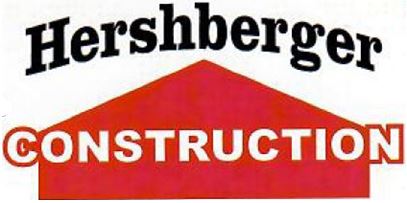Pole Barns 101
Does your life feel a bit cramped?
Do you dream of acquiring a spacious storage or workspace solution—without breaking the bank?
If you’re facing the challenge of finding the right solution that fits your budget and satisfies functional requirements, you’re not alone. Many homeowners and businesses struggle with the high costs and lengthy timelines associated with traditional construction projects.
At Hershberger Construction, we understand your struggle. You deserve a simple, efficient, and affordable way to expand your property and achieve your building goals. This is where pole barns might just be the answer you’ve been seeking.
In this blog post, we will explore what pole barns are and how they differ from traditional barns and discuss their benefits and diverse uses. As a leader in the construction and agriculture sector, we are here to guide you through everything you need to know about this increasingly popular building solution.
What Are Pole Barns?
The term “pole barn” often sparks curiosity. So, what exactly is a pole barn?
At its core, a pole barn, also known as a post-frame barn, is a type of post-frame construction. Unlike traditional barns with load-bearing walls, pole barns use vertical posts driven directly into the ground or onto a concrete pier foundation.
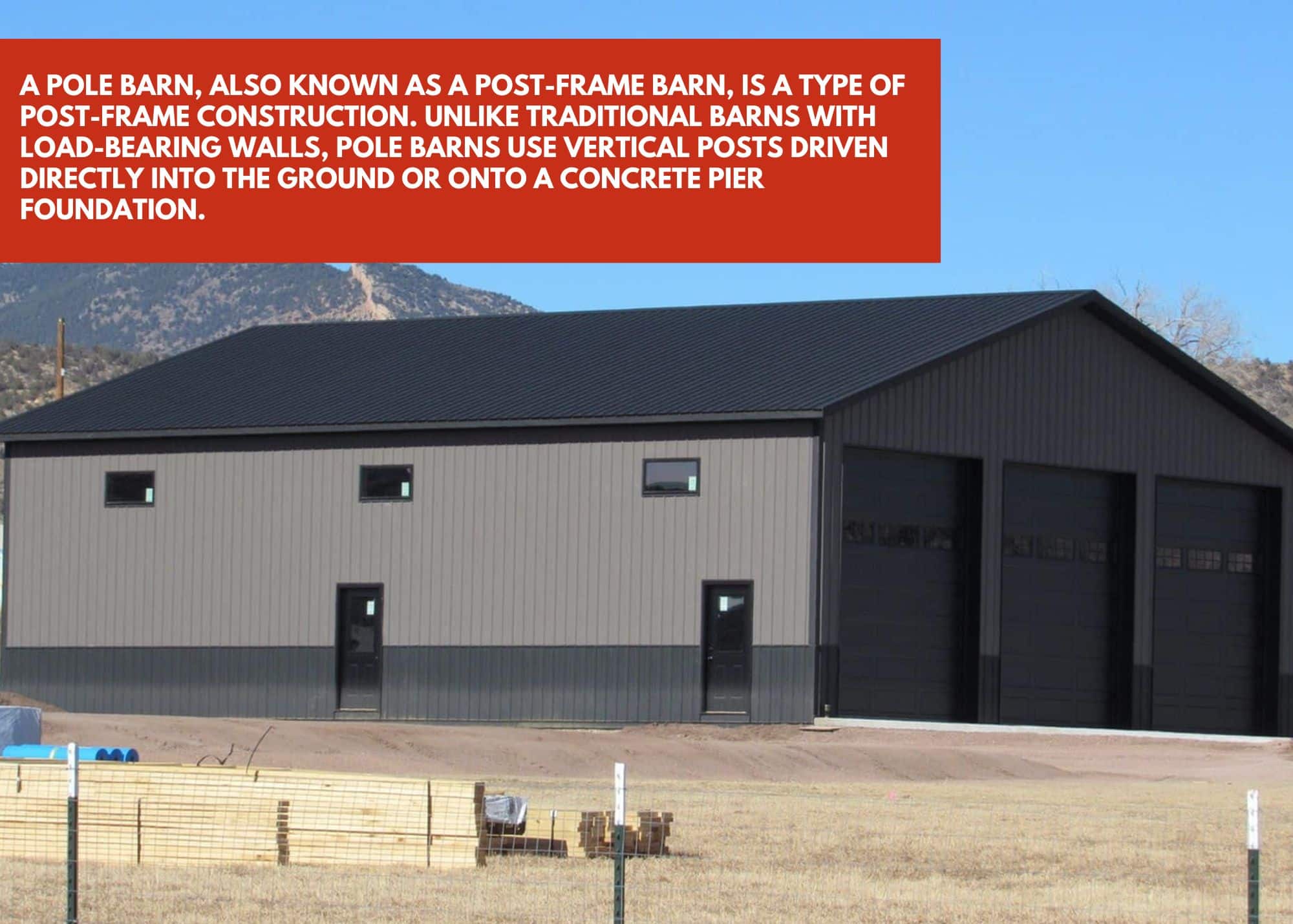
This simple design, coupled with horizontal beams and trusses, creates a strong and durable framework. Using the poles as the primary support for the roof eliminates the need for interior walls and provides an open, spacious interior.
The earliest pole barns were primarily used for agriculture. They served as shelters for livestock and storage for farming equipment. However, as you’ll see, their applications have since expanded dramatically. For more on the fascinating evolution of farm structures, including the rise of the pole barn, check out our previous blog post: Pole Barns: Versatile Solutions for Storage, Agriculture, Residential Needs, and Beyond.
Differences Between Pole Barns and Traditional Barns
The structural differences between pole barns and traditional barns are significant. Understanding these distinctions is essential, especially for those considering construction options.
- Foundation:
-
- Traditional Barns: Typically require a full foundation, which involves extensive excavation and concrete work. This adds significantly to the overall cost and construction time.
- Pole Barns: Use poles driven into the ground, reducing the need for a complete foundation and cutting down construction time and costs. This simple, cost-effective approach is one key reason why pole barns are more budget-friendly.
- Construction Speed:
-
- Traditional Barns: Building a traditional barn can be a lengthier process due to its complex structure.
- Pole Barns: Generally quicker to construct, thanks to the simplified post-frame design. This streamlined construction method of pole barns also significantly reduces overall build times.
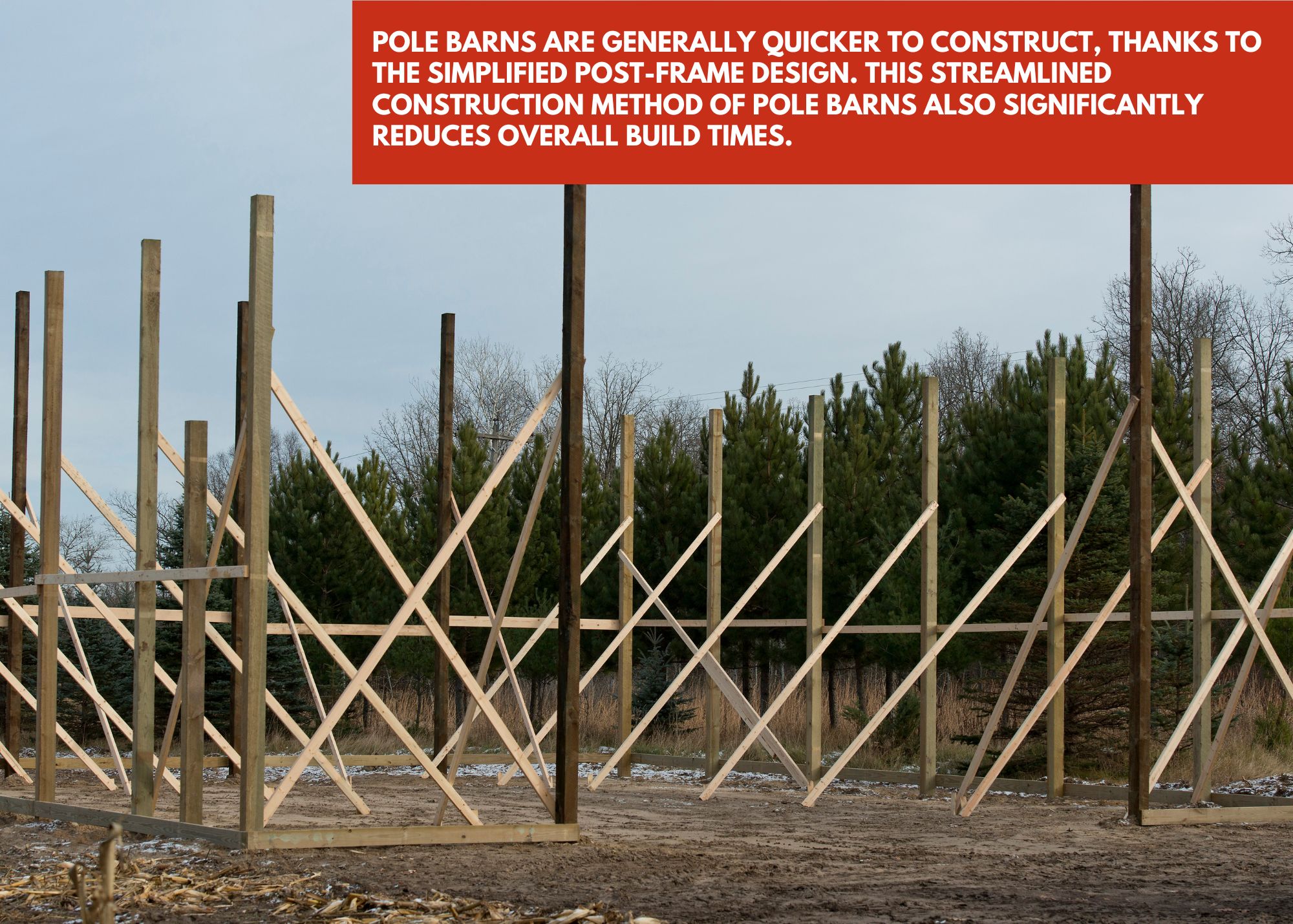
- Structural Flexibility:
-
- Traditional Barns: Less flexibility due to their rigid framework.
- Pole Barns: The adaptability of pole barns is noteworthy; they can be customized to meet a variety of needs. They allow for flexible design elements and the potential for expansion without significant modifications.
- Cost-effectiveness:
-
- Traditional Barns: Might incorporate stone, brick, or other materials. This leads to higher costs due to labor and materials.
- Pole Barns: Frequently utilize wood, steel, and engineered lumber. This is more cost-effective due to reduced material and labor requirements.
Benefits of Pole Barns
So why choose a pole barn over a traditional stick-framed building?
Well, pole barns have a number of advantages that don’t come with every type of building. Here are some benefits of a pole barn:
1. Cost-Efficiency:
As previously noted, pole barns are generally more affordable. Their simplified construction process and reduced need for materials contribute to significant savings. The absence of a concrete foundation contributes to this lower building cost.
2. Versatility:
Pole barns don’t have interior load-bearing walls. This allows for a wide-open interior that allows for adaptation to various purposes.
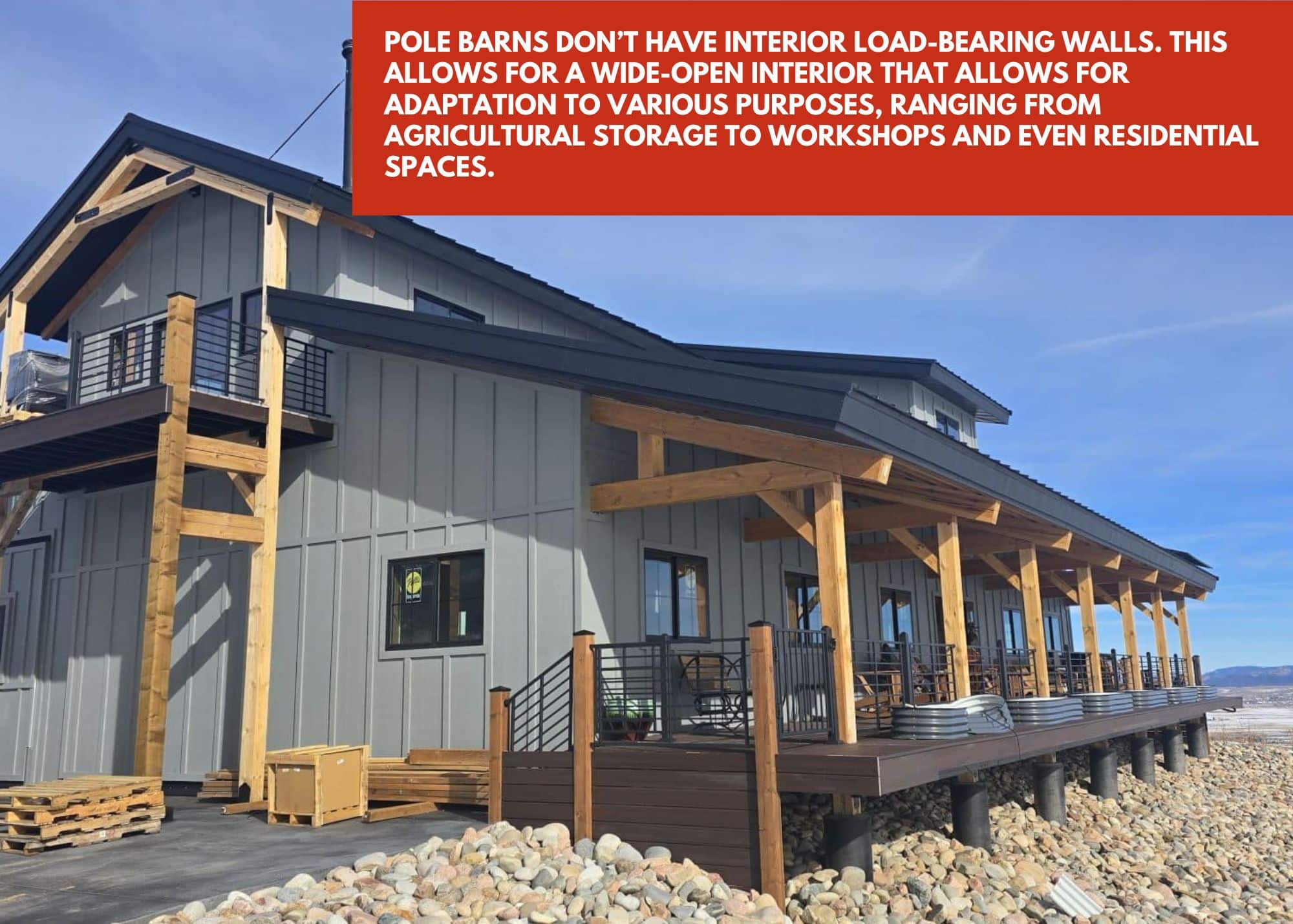
This adaptability caters to diverse needs and preferences. These range from agricultural storage to workshops and even residential spaces.
3. Quick Construction:
Pole barns can be constructed quickly due to their simple design. They use fewer materials and require less time for framing compared to traditional buildings. With minimal site preparation requirements, they can often be completed in days rather than weeks.
4. Durability:
Built to withstand a variety of weather conditions, pole barns offer long-lasting durability. Using treated poles and steel siding ensures resistance to decay and pests. When constructed with high-quality materials and properly maintained, pole barns can last for 60+ years.
5. Ease of Maintenance:
Pole barns, with their simpler construction and fewer moving parts, often require less maintenance than traditional structures. With fewer joints and connections, there are reduced potential points of failure. This means less time spent on routine maintenance tasks like painting, caulking, and replacing shingles.
6. Energy Efficiency:
With the proper insulation, pole barns can be just as energy-efficient as traditional buildings. Pole barns can be easily insulated due to their large, contiguous surfaces. Plus, they can be adapted to include features such as energy-efficient doors and windows.
These benefits make it possible to tailor your pole barn to fit your exact requirements.
Uses for Pole Barns
The uses for pole barns are virtually endless, which makes them an attractive option for many individuals and businesses. Here are some common applications:
- Agricultural Storage: Pole barns have an open design that provides space to store large equipment, supplies, and feed. They are frequently used to store farm equipment, hay, grain, or other agricultural supplies.
- Livestock Shelters: Pole barns are excellent, cost-effective animal shelters, including cows, horses, and poultry. Their open design enables multiple options for multiple pens or stalls.
- Garages: Pole barns make practical garages, whether for hobby vehicles such as side-by-sides, four-wheelers, boats, and campers.
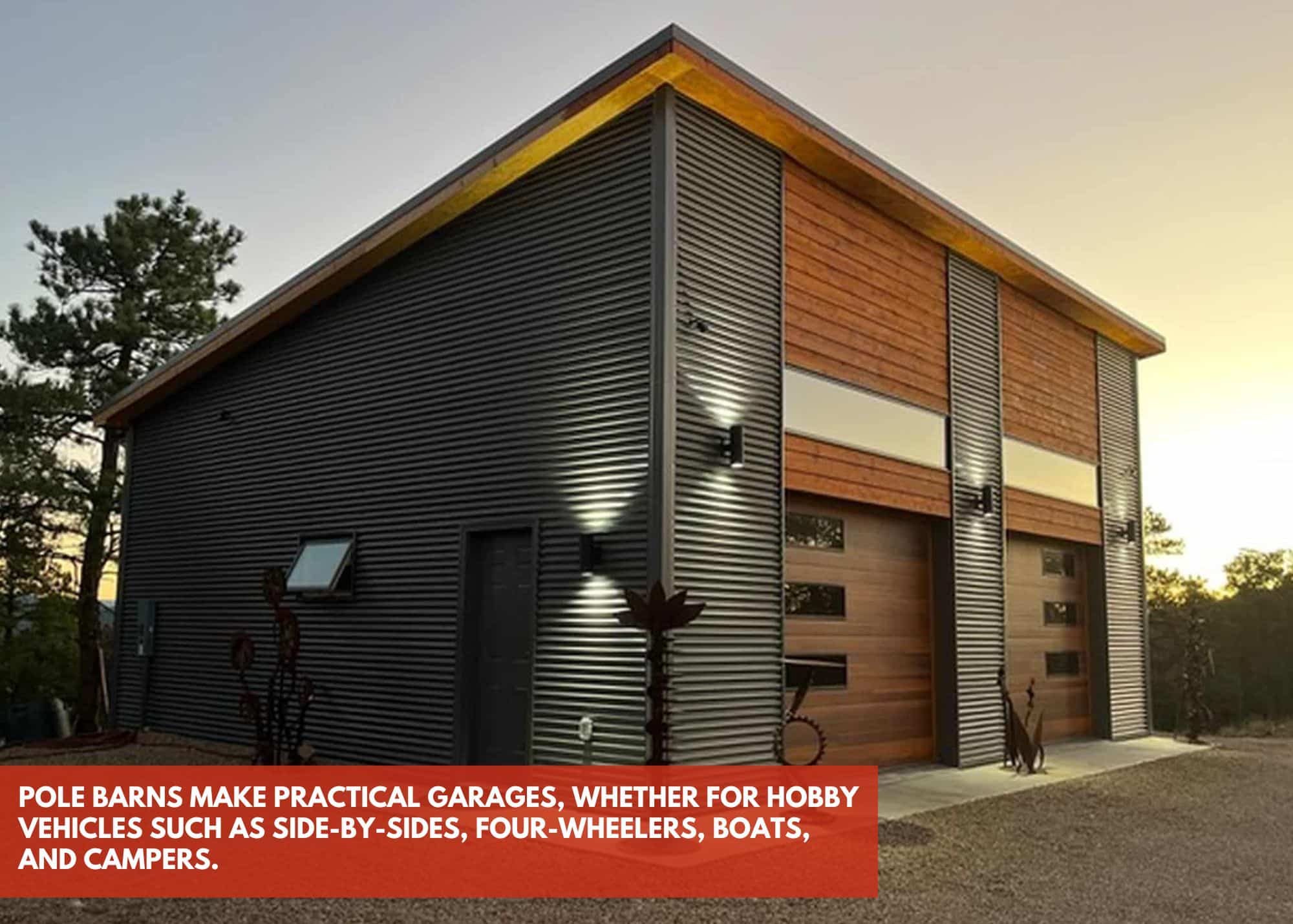
- Workshops: Whether you are an artist, woodworker, or mechanic, a pole barn provides ample space for creative and professional pursuits.
- Event Venues: With spacious interiors and rustic charm, pole barns are increasingly used as unique venues for weddings and other events.
- Residential Homes: Yes, you heard that right! Pole barns have now made their mark in residential construction, offering a cost-effective and durable way to build homes with open floor plans.
- Retail and Commercial Spaces: Businesses opt for pole barns as stores and offices due to their flexibility and lower overhead costs. They can be adapted to serve as warehouses as well.
- Aircraft Hangers: The open design of a pole barn makes it ideal storage space for aircraft and aviation equipment for airplane enthusiasts or commercial airports.
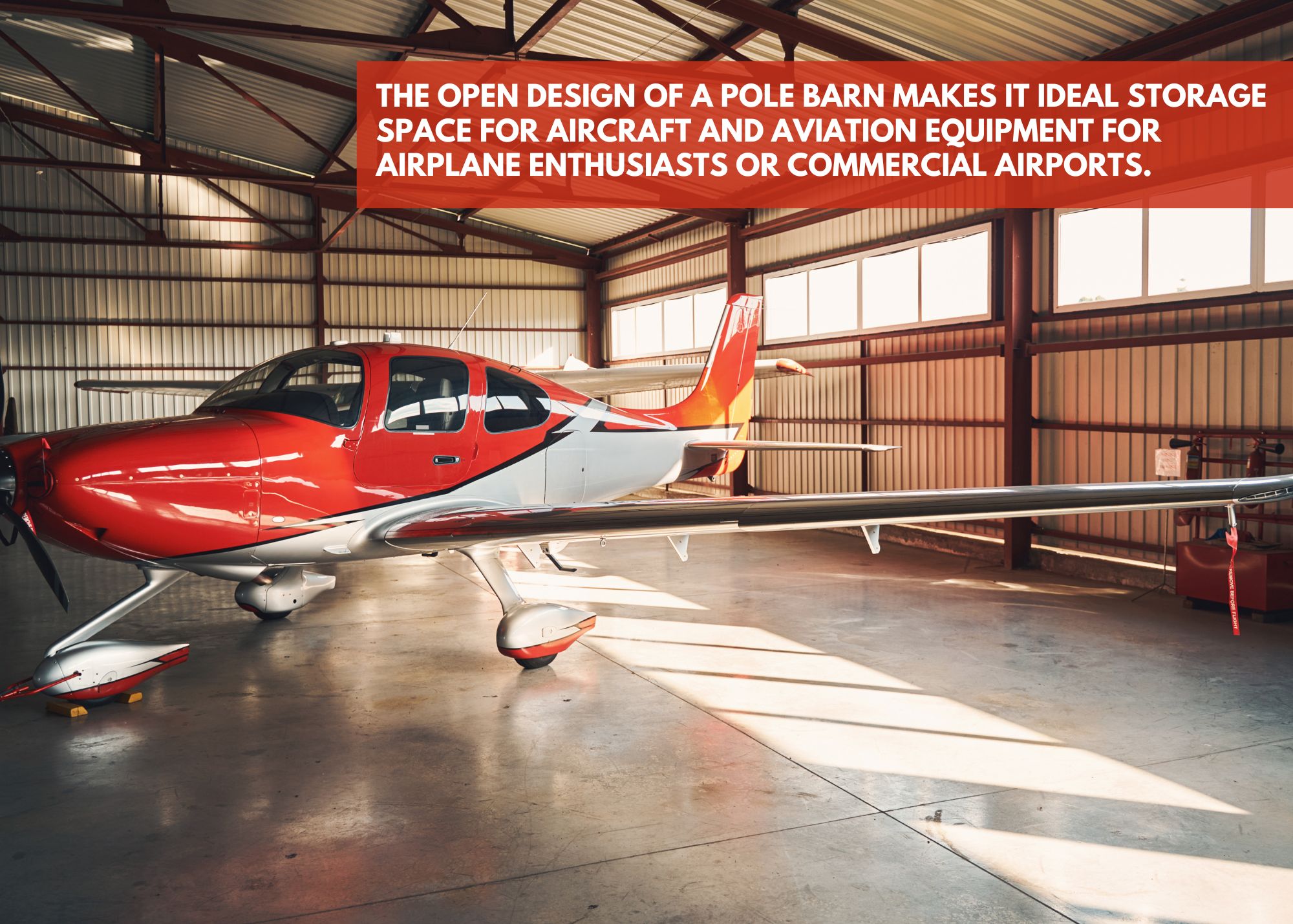
- Cold Storage: Pole barns are used increasingly in the food industry for cold storage of perishable goods.
- Equestrian Facilities: Horse owners and riders use pole barns as stables, riding arenas, or tack rooms.
Planning and Construction Tips
But wait, before diving into construction, there are several things to consider.
1. Site Selection:
Carefully choose the location of your pole barn, considering factors such as access, utilities, and local regulations. Select an area that provides adequate drainage and is accessible for construction equipment.
2. Design:
Once the location is finalized, you must develop a detailed design that reflects your specific requirements. Choose suitable materials, considering the building’s intended use and environmental conditions. Customizing your pole barn is a fantastic way to enhance its functionality and aesthetic appeal.
3. Zoning and Permits:
Consult local regulations to ensure your pole barn meets zoning requirements. Remember, securing the necessary permits is crucial to avoid any legal hurdles.
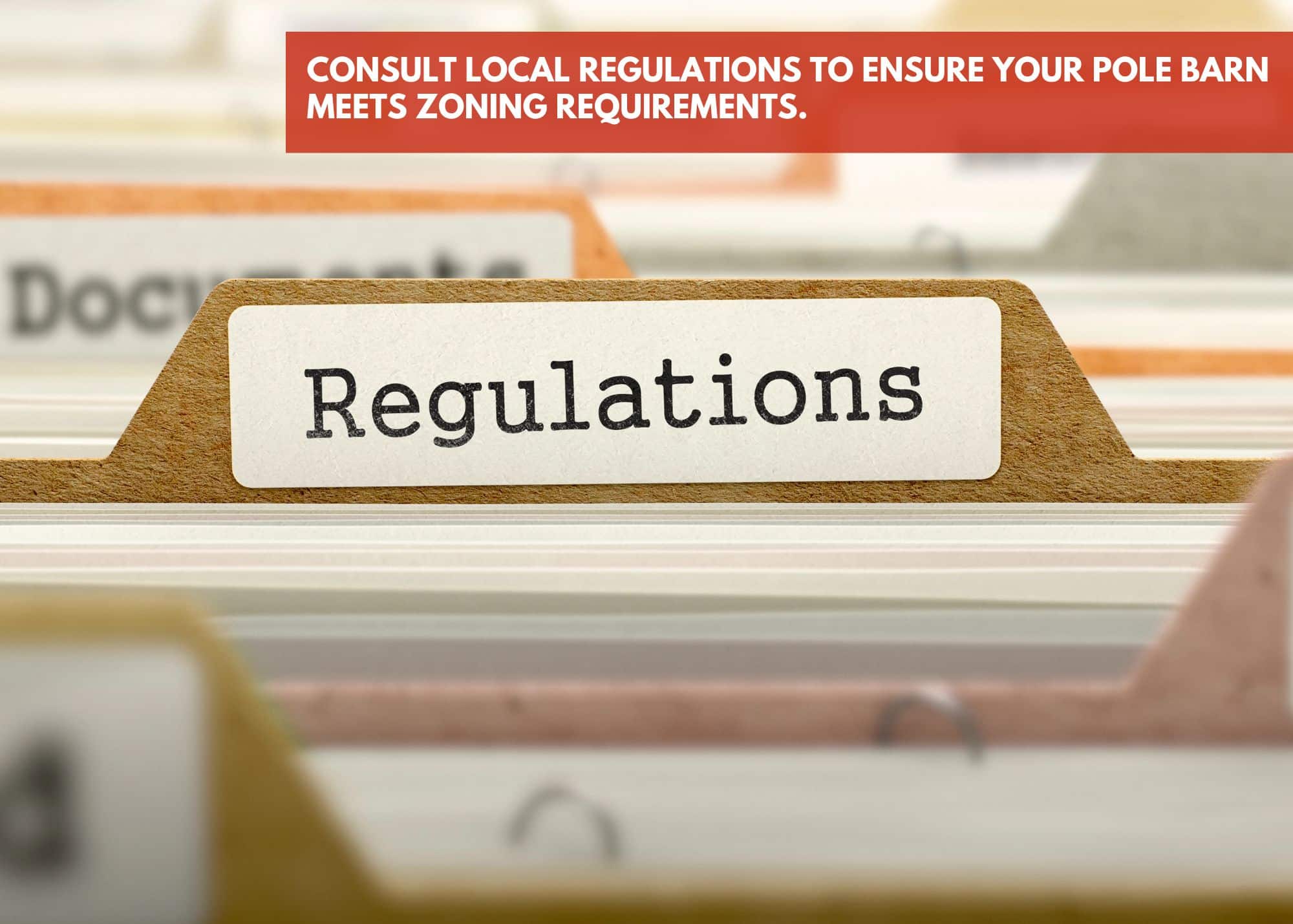
4. Budgeting:
Establish a realistic budget encompassing materials, labor, and any additional features you want, such as electricity and plumbing. Secure financing if needed.
5. Expert Consultation:
Engage professionals with experience in pole barn construction (like Hershberger Construction) to ensure your project runs smoothly from start to finish.
Remember that customization is key: consider tailoring your design to fit your specific climate and needs.
Conclusion
Pole barns are practical, versatile, and affordable solutions for many applications, from agriculture to residential use. With their unique pole-frame construction, these barns offer many benefits, including cost efficiency, durability, and ease of use. By understanding what pole barns offer and partnering with industry experts, you are now well-equipped to make informed decisions and confidently move forward.
Ready to explore the possibilities?
Hershberger Construction is prepared to transform your vision into reality. They will guide you every step of the way, bringing expertise and innovation to your project. Whether you need a new agricultural storage shed or a custom-designed workshop, find the solutions tailor-made for your needs.
Contact us today to bring your vision to life with a customized pole barn solution.
